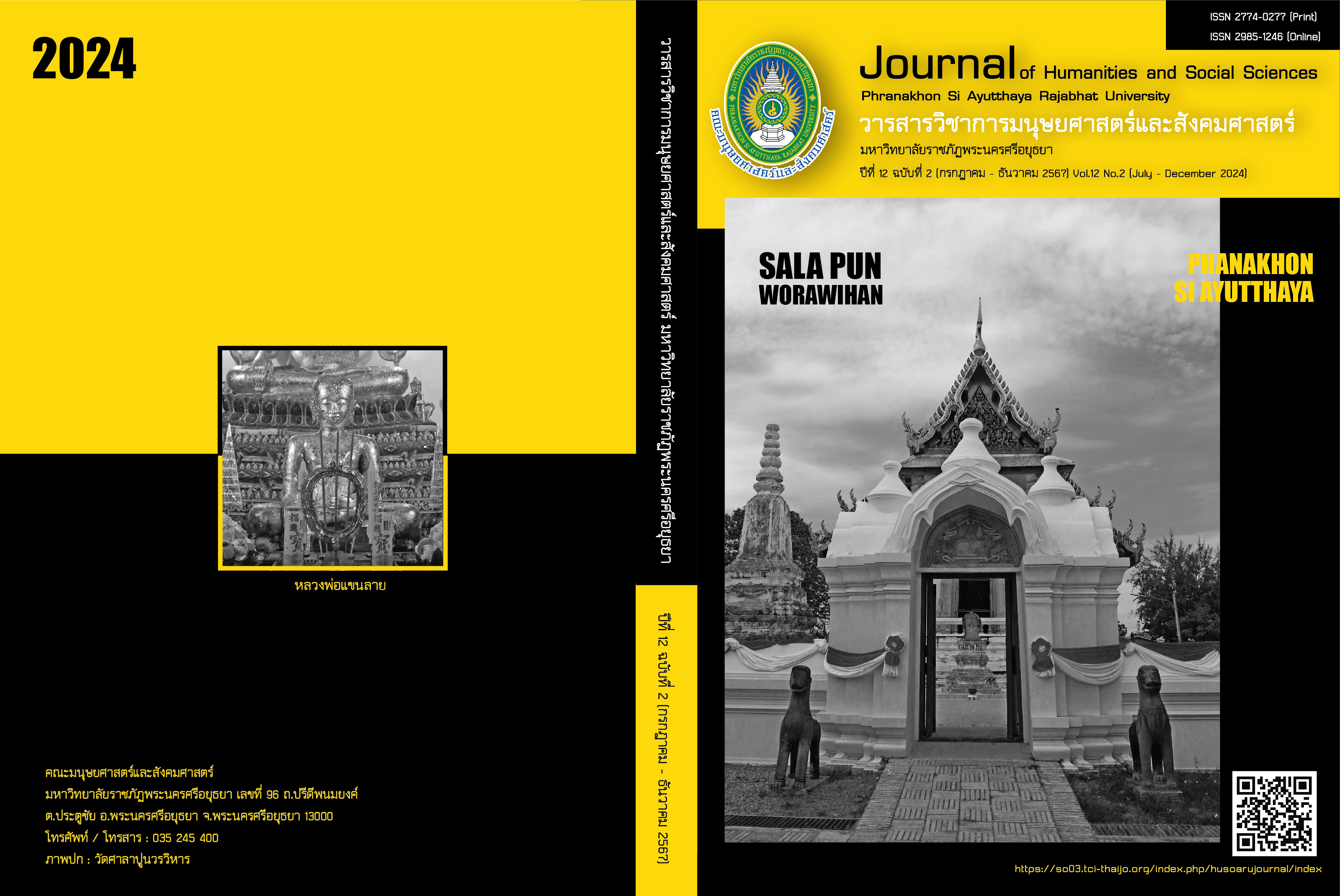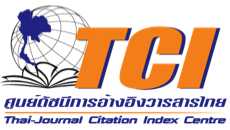Dress Identity of the Annam Niyaka Buddhist Sanga in Thailand
DOI:
https://doi.org/10.14456/husoaru.2024.14Keywords:
Buddhism, Anam Nikaya, Dress IdentityAbstract
This article aims to explain the dress identity of the Annam Nikaya Sangha of Thailand. during the reign of King Ramkhamhaeng the Great His Highness has adopted Buddhism as the national religion, patronized and maintained to prosper until now and is an important sect that has been with Thai society ever since. Continuing and long, there are 2 sects who are Theravada Buddhism and Mahayana Buddhism. Later, during the reign of King Rama V, the Annam Nikaya Sangha was established in Thailand, thus a sect of Mahayana Buddhism from Vietnam came to Bangkok and later received patronage. from the Chinese and Thai communities for political and cultural reasons; which in the dress of the Anam Nikaya Sangha of Thailand today Monks of the Annam and Chinese sects wear shirts and pants, wear their robes, and do not shave their eyebrows. This is different from Theravada monks who wear robes, sangkhati and shave their eyebrows.However, religious identity, concepts and practices related to customs and assemblies various rituals of the Mahayana Ananam Nikaya Sangha in Thai society, it can be seen that in addition to wearing robes of monks in the Mahayana sect with various forms “Rituals inherited for a long time This resulted in the succession to a religious organization called "Anam Nikaya" with the appearance of the identity of the Vietnamese monks or the Anam Nikaya Sangha, i.e. the identity of the dress from then on.
References
คณะสงฆ์อนัมนิกายแห่งประเทศไทย. (2556). อนัมศึกษาชั้นมัธยมศึกษาปีที่ 1 วัดสุนทรประดิษฐ์ (คั้นอังตื่อ).
ฉลาดชาย รมิตานนท์. (2545). แนวคิดในการศึกษาอัตลักษณ์ความเป็นไท. มหาวิทยาลัยเทคโนโลยีพระจอมเกล้าธนบุรี.
พระธรรมปิฎก (ป.อ.ปยุตฺโต). (2546). พจนานุกรมพุทธศาสตร์ ฉบับประมวลธรรม (พิมพ์ครั้งที่ 12). โรงพิมพ์มหาจุฬาลงกรณราชวิทยาลัย.
พระบริหารอนัมพรต (ถาวร มินเอิง). (2543). อุภัยฉลอง. ประชาชน.
พระพุทธโฆษาจารย์ (อาจ อาสภมหาเถร). (2546). คัมภีร์วิสุทธิมรรค (พิมพ์ครั้งที่4). ประยูรวงศ์พริ้นท์ติ้ง.
พระราชบัญญัติคณะสงฆ์ (ฉบับที่ 2) พ.ศ. 2535. (2535). ราชกิจจานุเบกษา, 109(16), 5-11.
พิธีทอดผ้าป่า ประวัติความเป็นมาของการทำบุญทอดผ้าป่า. (2554). DMC.TV. https://www.dmc.tv/ประวัติความเป็นมาของการทำบุญทอดผ้าป่า-พิธีทอดผ้าป่า_LEFT.html
พุทธทาส ภิกขุ. (2543). สุญญตา. กองตำราคณะธรรมทาน สวนโมกขพลาราม.
มหาจุฬาลงกรณราชวิทยาลัย. (2539). พระไตรปิฎกภาษาไทยฉบับมหาจุฬาลงกรณราชวิทยาลัย. โรงพิมพ์มหาจุฬาลงกรณราชวิทยาลัย.
ยุรฉัตร บุญสนิท. (2546). ลักษณะความสัมพันธ์ของวรรณกรรมกับสังคม. ใน พัฒนาการวรรณคดี. มหาวิทยาลัยสุโขทัยธรรมธิราช.
ร้านต่อบุญ 2559. (2566). สีจีวรผ้าไตร ที่วัดไทยใช้. http://www.sasiraboon.com/article/36/สีจีวรผ้าไตร
หลวงวิจิตรวาทการ. (2546). ศาสนาสากล (เล่ม 2). สร้างสรรค์บุ๊คส์.
สถิต วงศ์สวรรค์. (2540). การพัฒนาบุคลิกภาพ. อักษรพิทยา.
องปลัดสิทธิศักดิ์ เถี่ยนยา (แซ่โค้ว). (2557). การบริหารจัดการประสิทธิภาพการสาธารณะสงเคราะห์ของคณะสงฆ์อนัมนิกายในประเทศไทย [วิทยานิพนธ์ปริญญาดุษฎีบัณฑิต]. มหาวิทยาลัยมหาจุฬาลงกรณราชวิทยาลัย.
องสรภาณอนัมพจน์ (พิสิษฐ์เถี่ยนบ๊าว/ศรีวิชา). (2546). การพัฒนารูปแบบการบริหารที่มีประสิทธิภาพของคณะสงฆ์อนัมนิกายในประเทศไทย [วิทยานิพนธ์ปริญญาดุษฎีบัณฑิต]. มหาวิทยาลัยมหาจุฬาลงกรณราชวิทยาลัย.
อรัสธรรม ดีระดอม. (2526). บทบาทของพระสงฆ์มหายานในการพัฒนาสังคม: ศึกษาเฉพาะกรณีพระสงฆ์จีนนิกายและอนัมนิกายในภาคกลางของประเทศไทย [วิทยา นิพนธ์ปริญญามหาบัณฑิต]. มหาวิทยาลัยธรรมศาสตร์.
Minh, C., Ha, V. T., & Nguyen, T. T. (1993). Buddhism in Vietnam. Gioi.
Nguyen, T. T. (Ed.). (2009). The history of Buddhism in Vietnam. Council for Research in Values and Philosophy.
Downloads
Published
How to Cite
Issue
Section
License
Copyright (c) 2024 Phranakhon Si Ayutthaya Rajabhat University

This work is licensed under a Creative Commons Attribution-NonCommercial-NoDerivatives 4.0 International License.
บทความที่ได้รับการตีพิมพ์เป็นลิขสิทธิ์ของ คณะมนุษยศาสตร์และสังคมศาสตร์ มหาวิทยาลัยราชภัฏพระนครศรีอยุธยา
ทัศนะและความคิดเห็นที่ปรากฏในบทความในวารสารฯ ถือเป็นความรับผิดชอบของผู้เขียนบทความ และไม่ได้เป็นทัศนะและความรับผิดชอบของ กองบรรณาธิการ หรือ ของ มหาวิทยาลัยราชภัฏพระนครศรีอยุธยา







